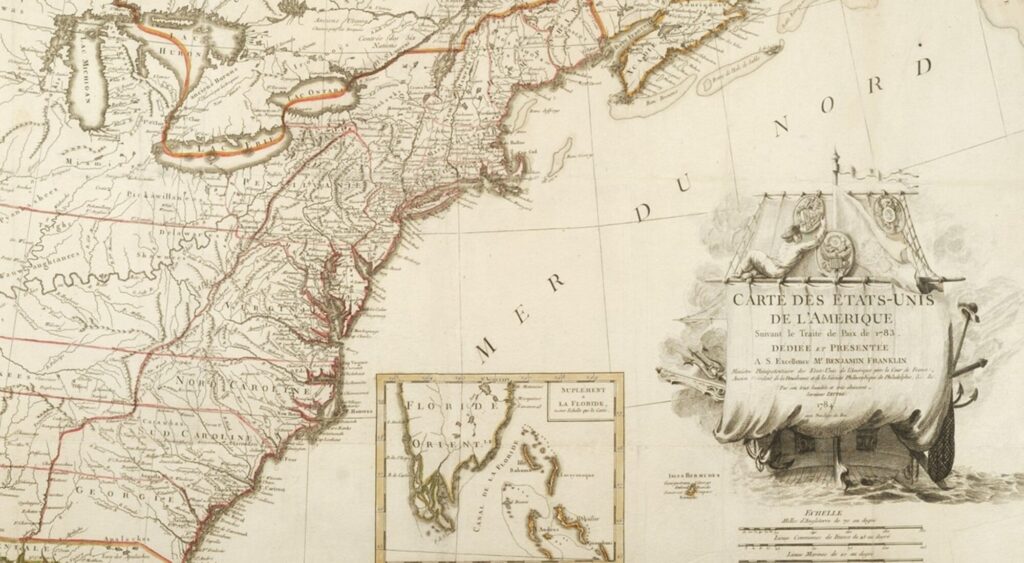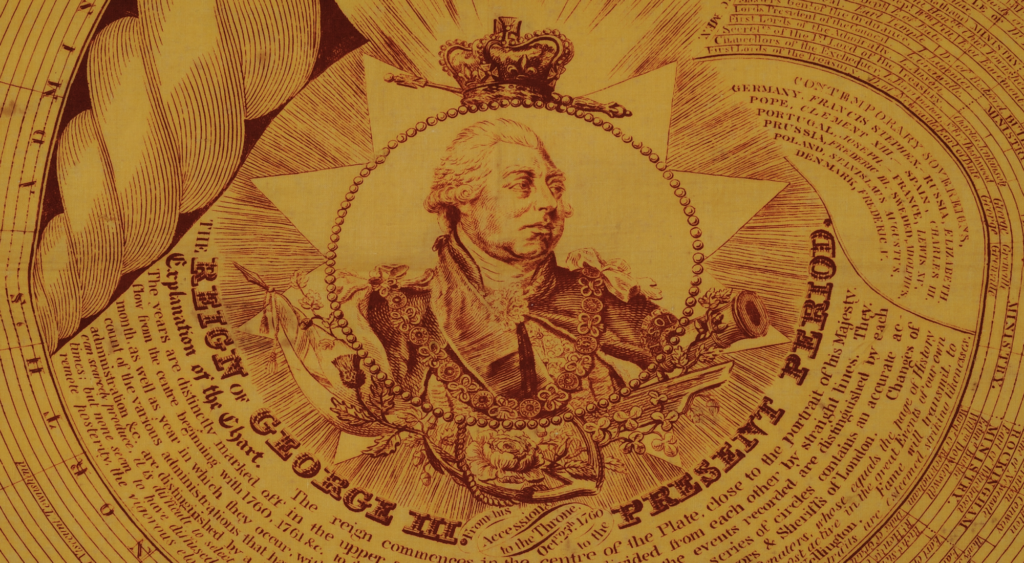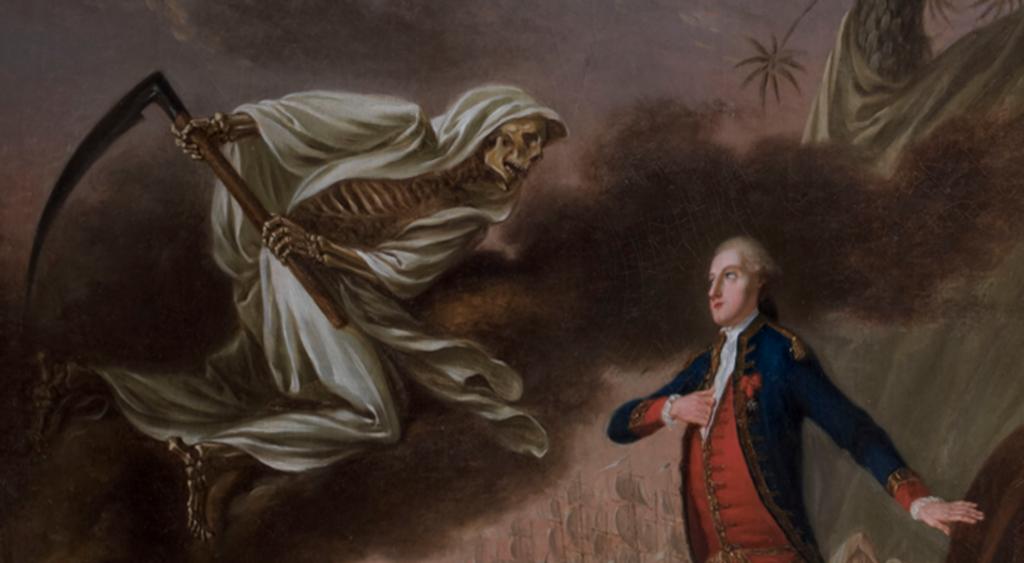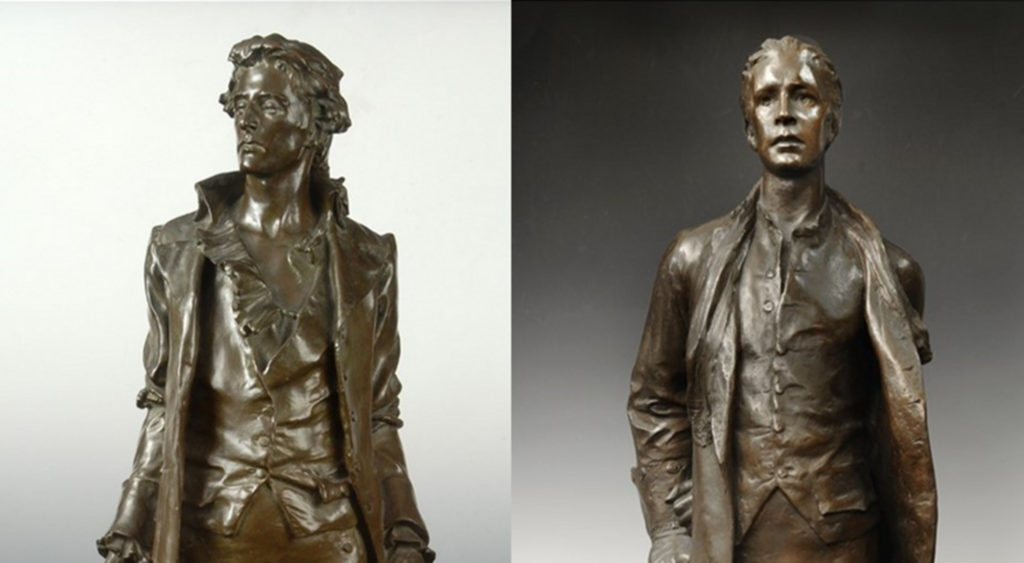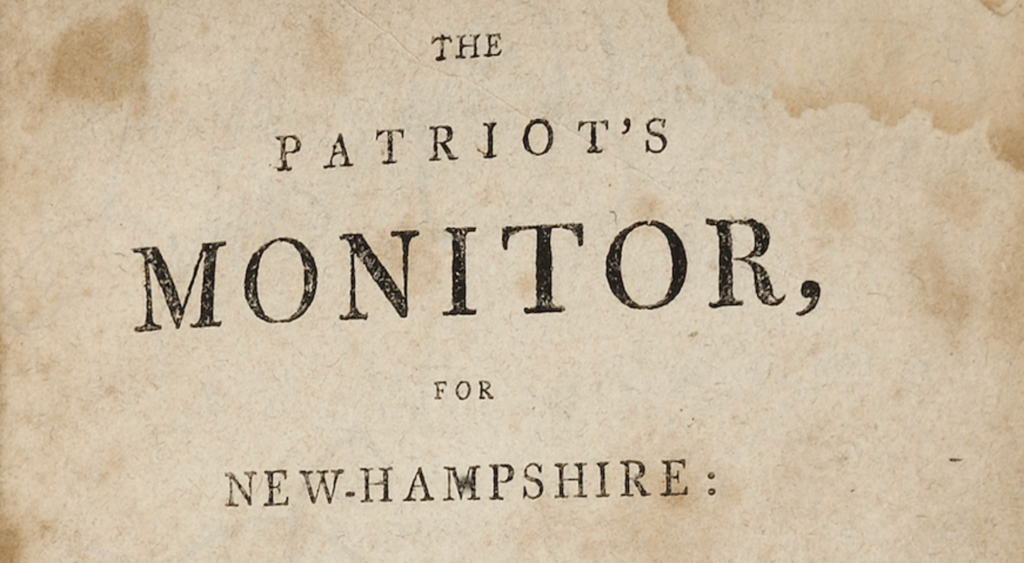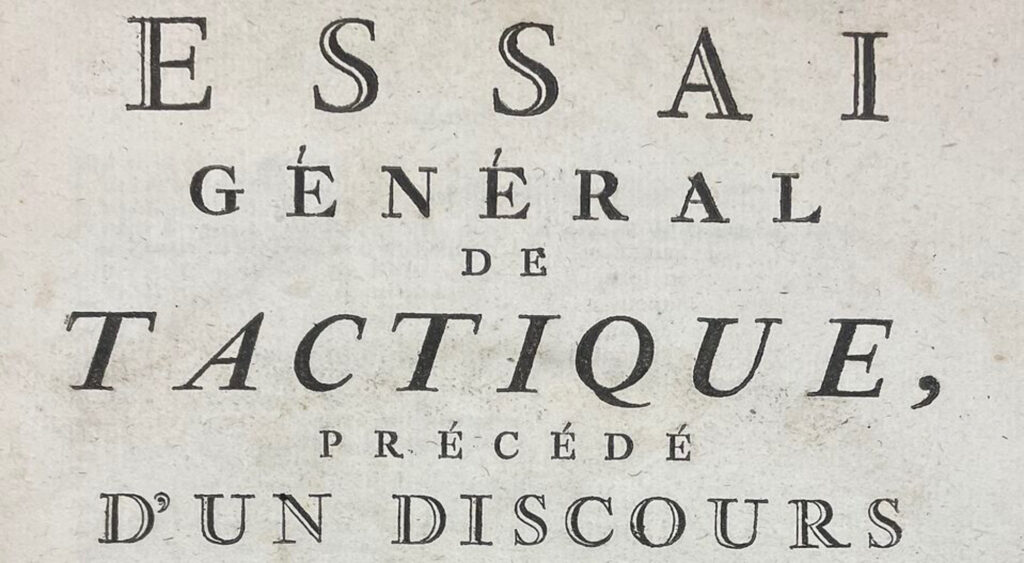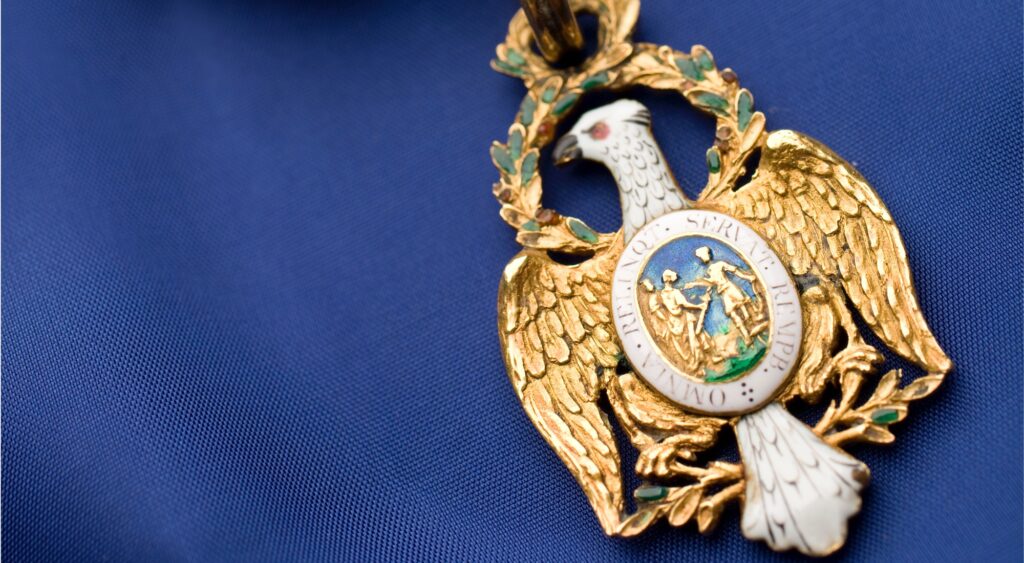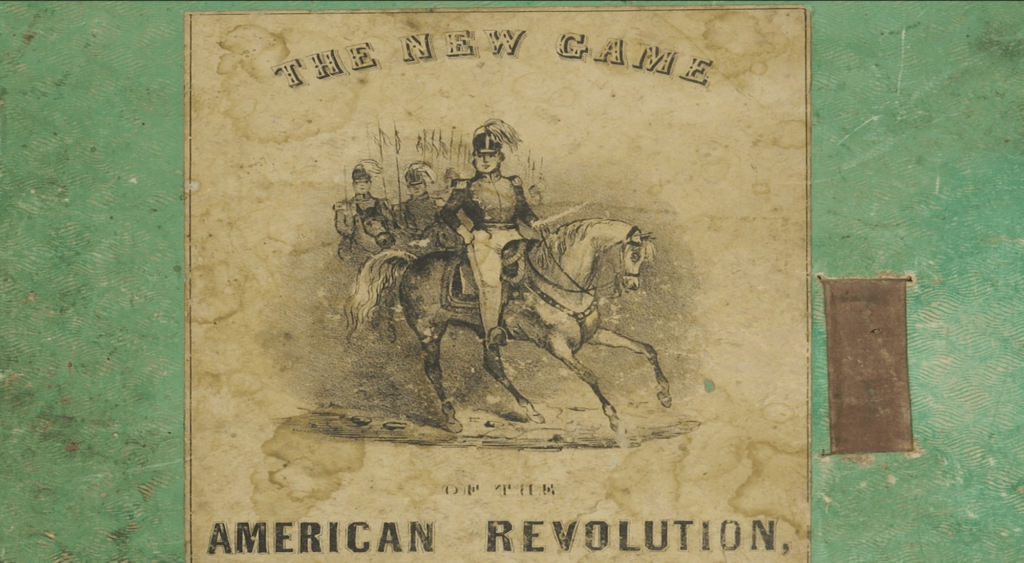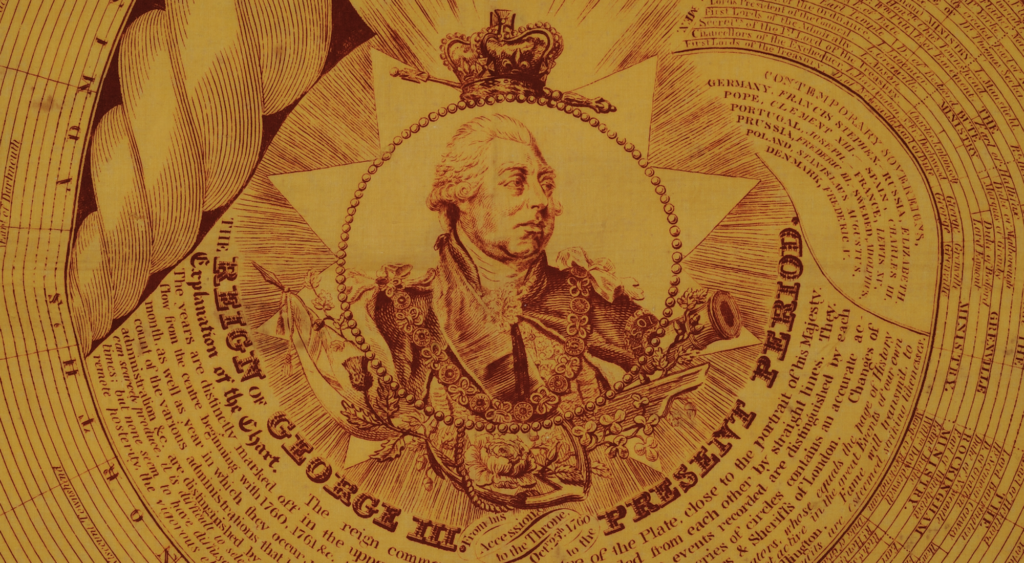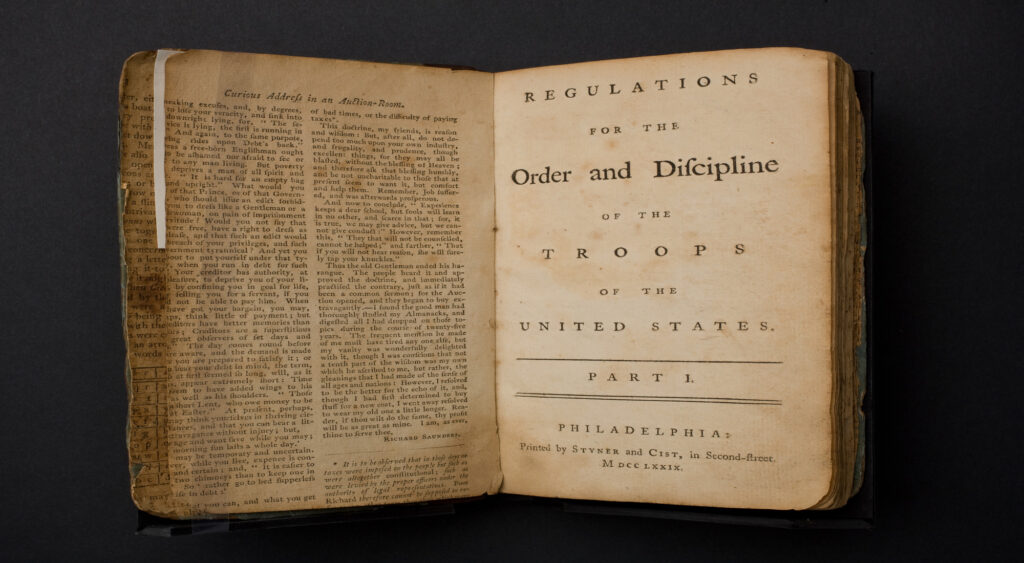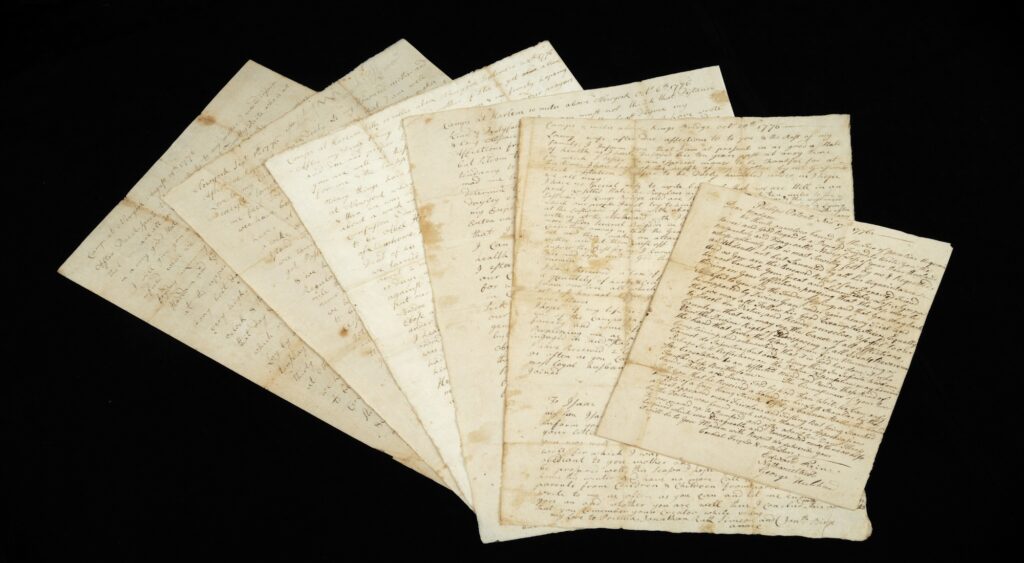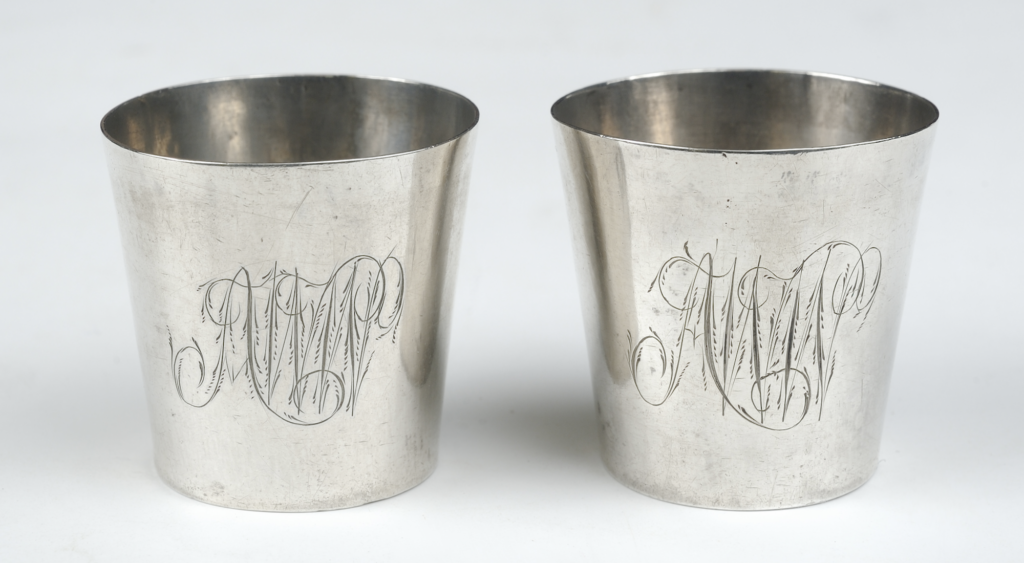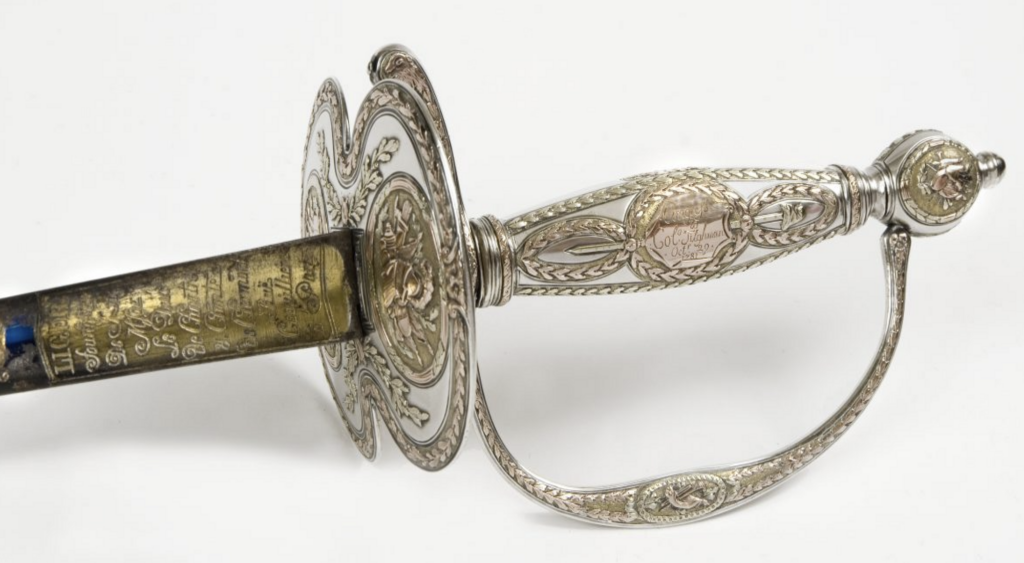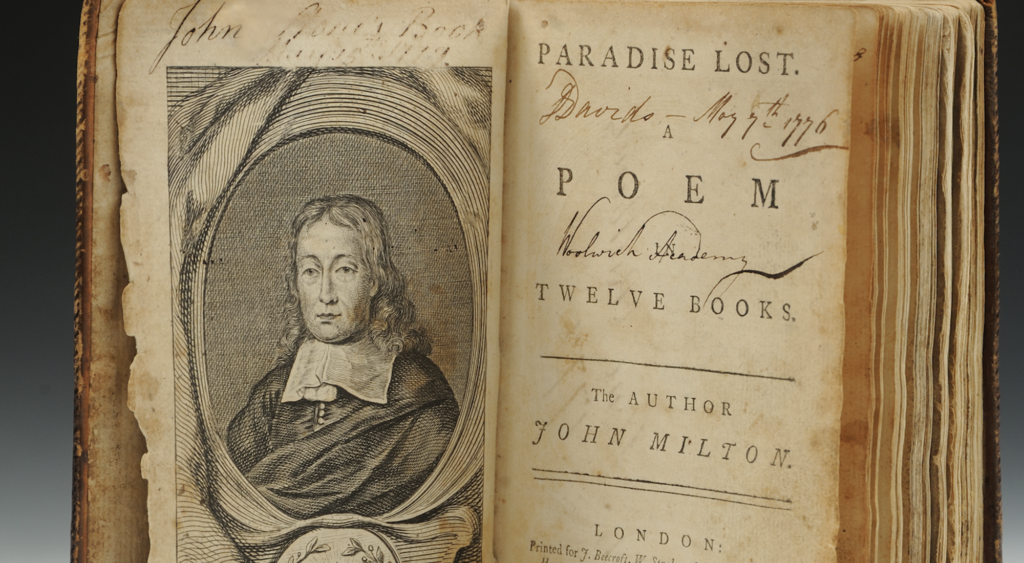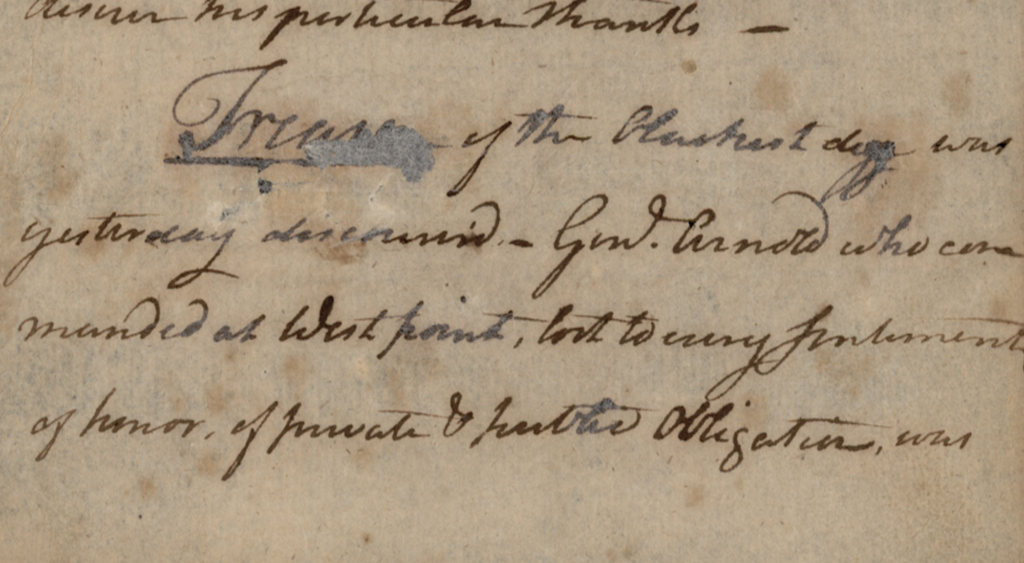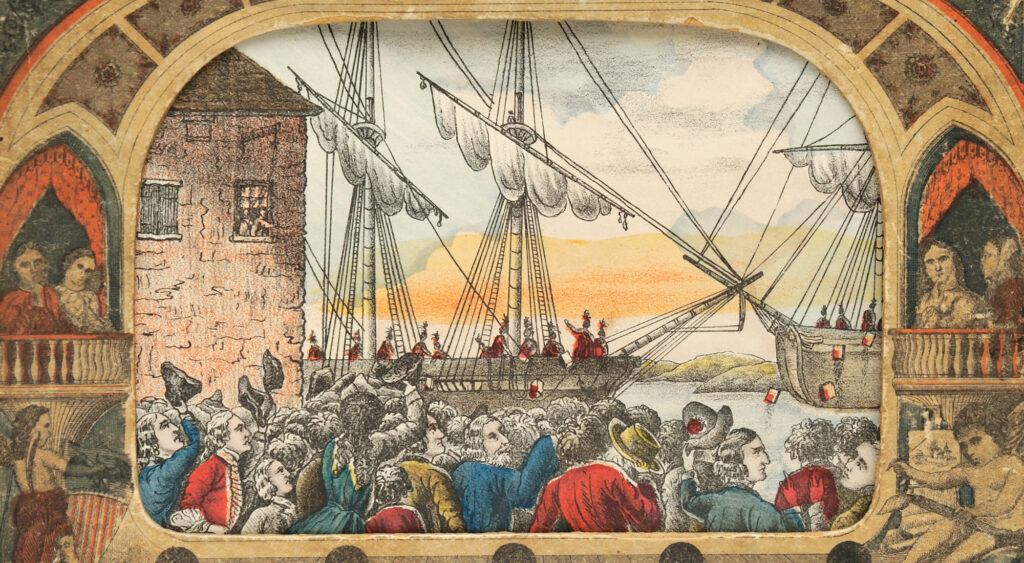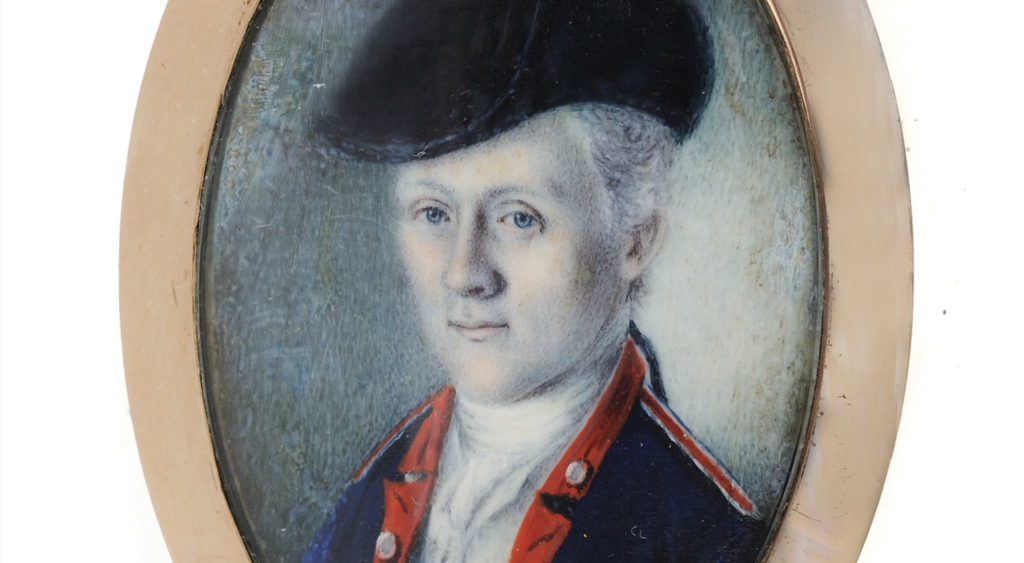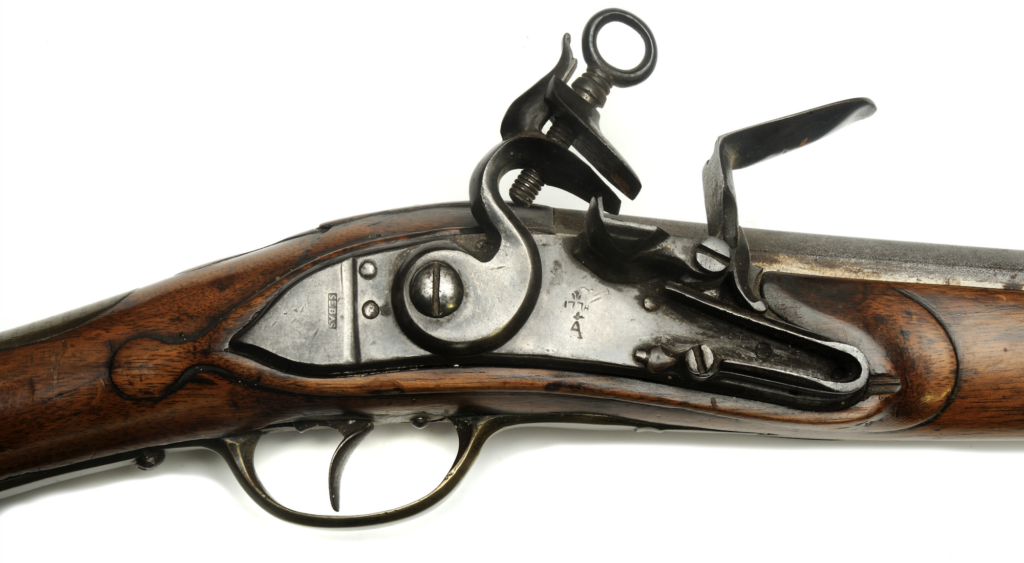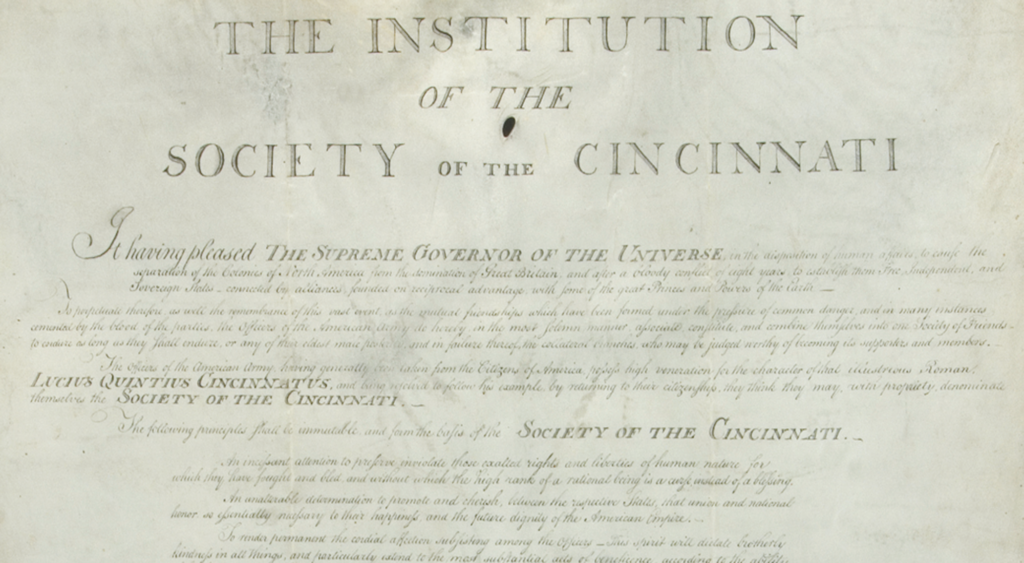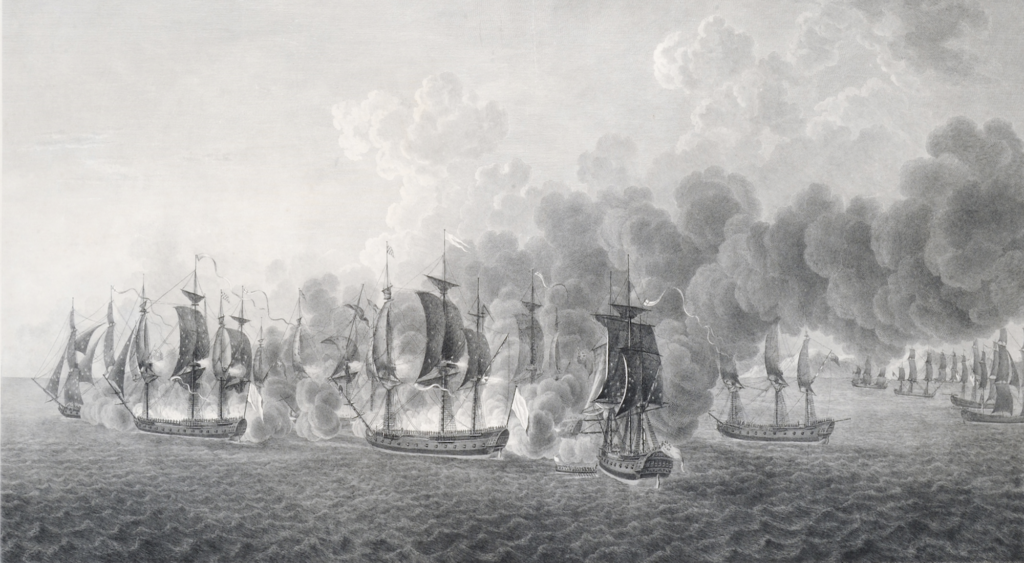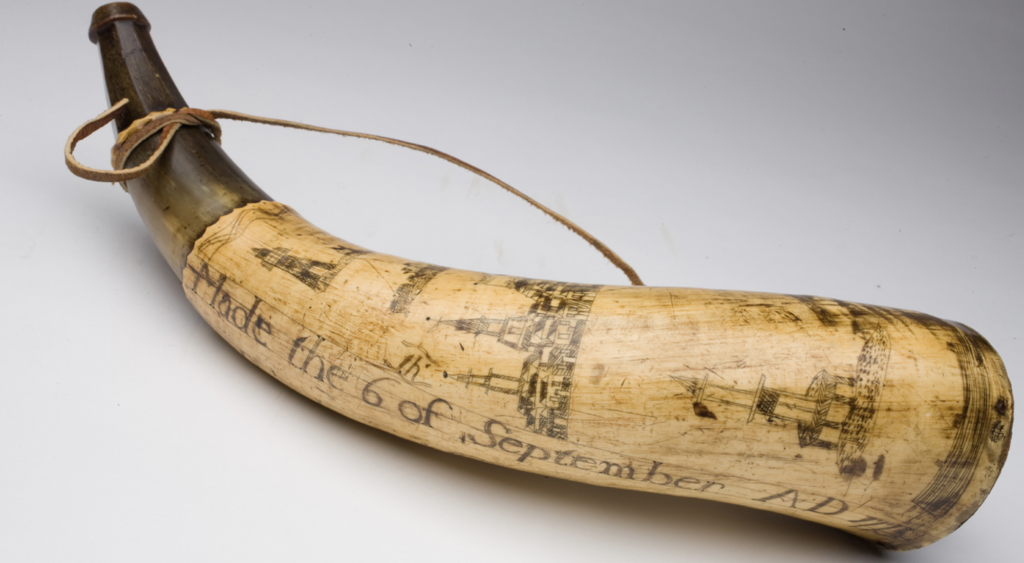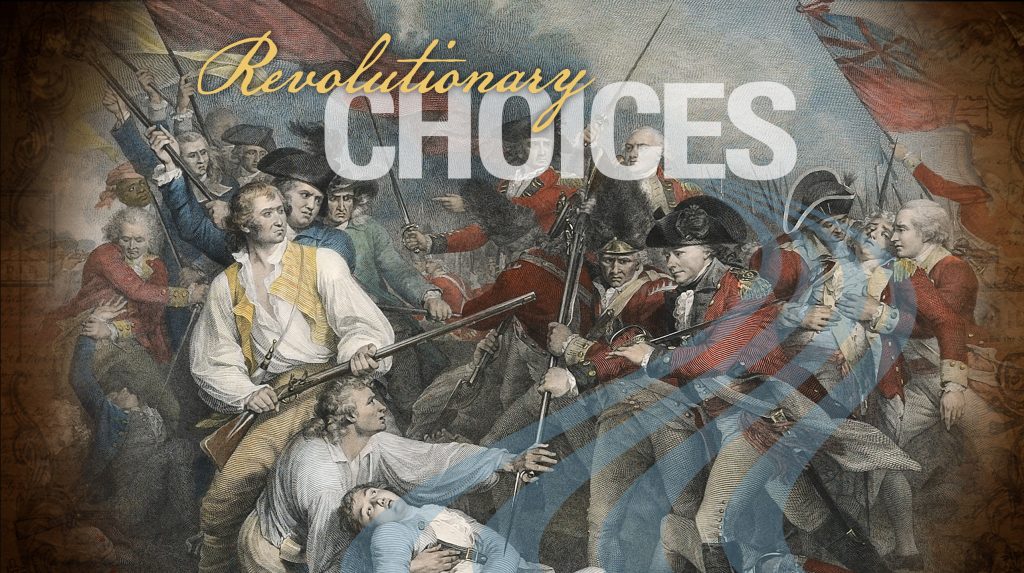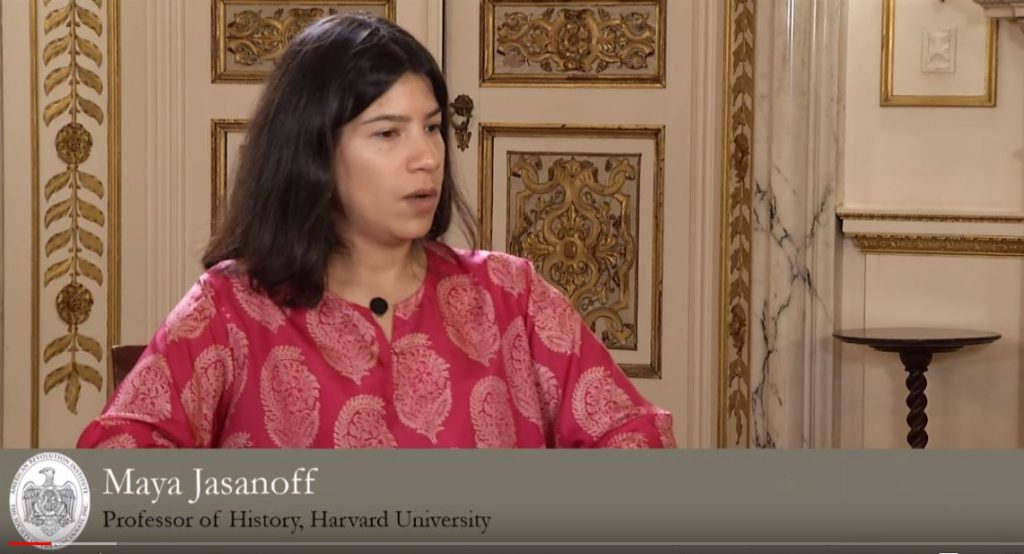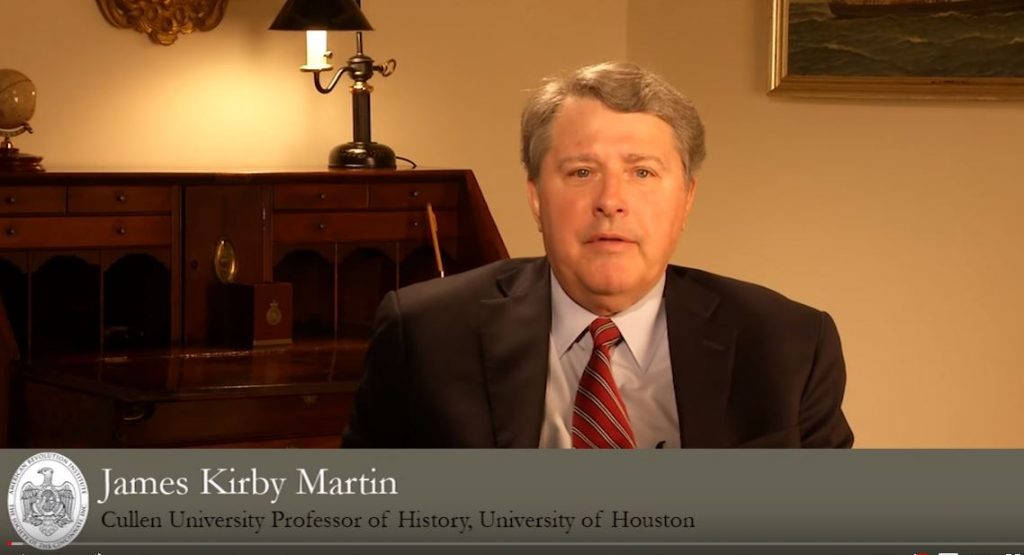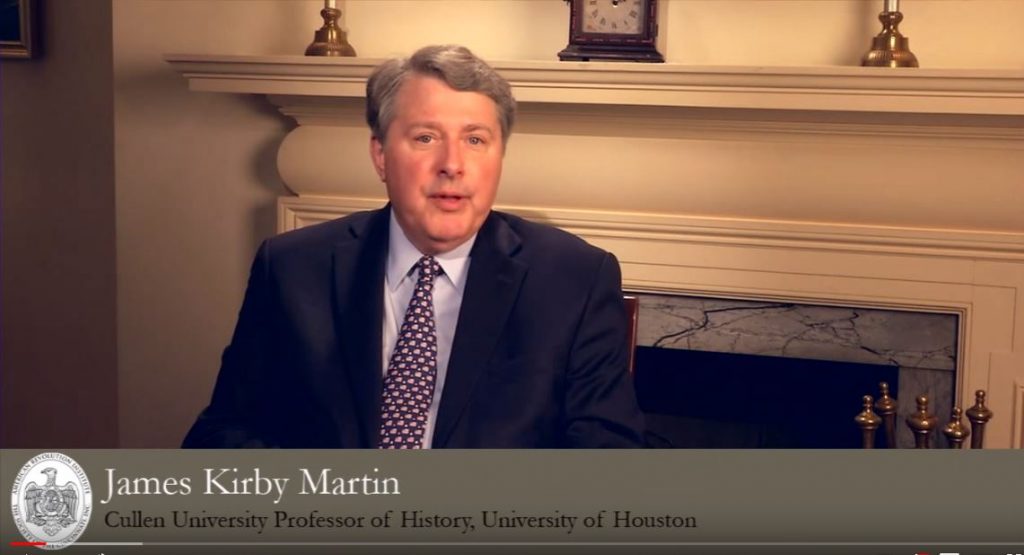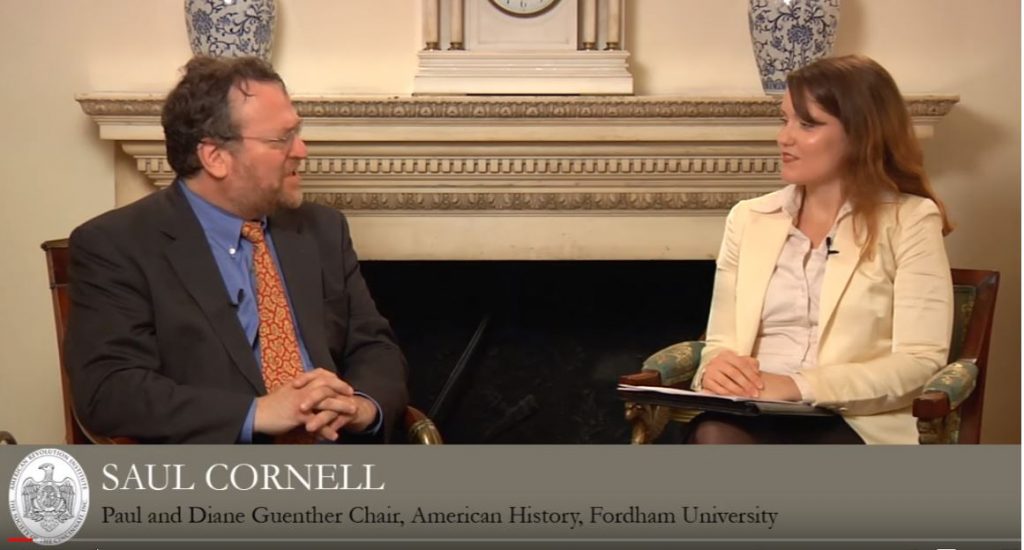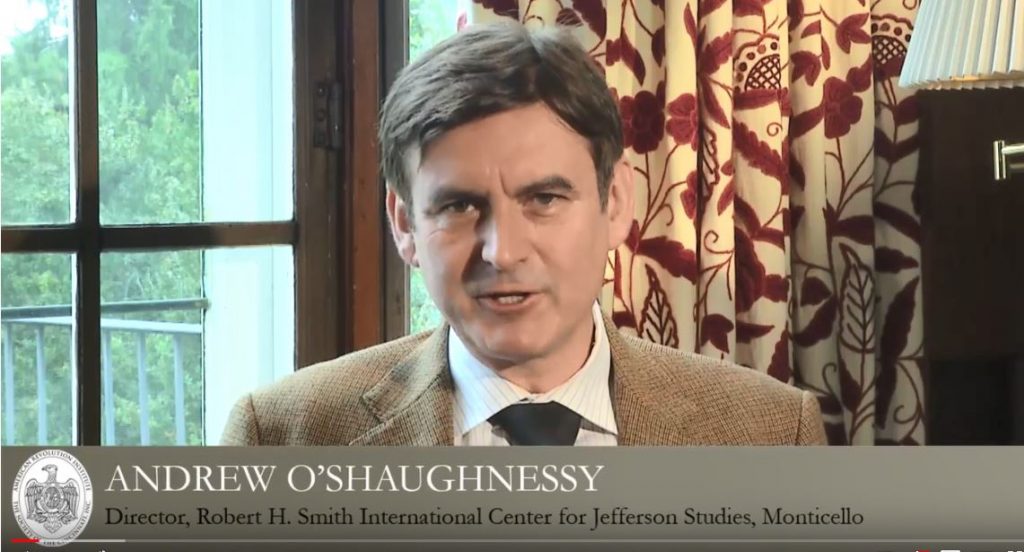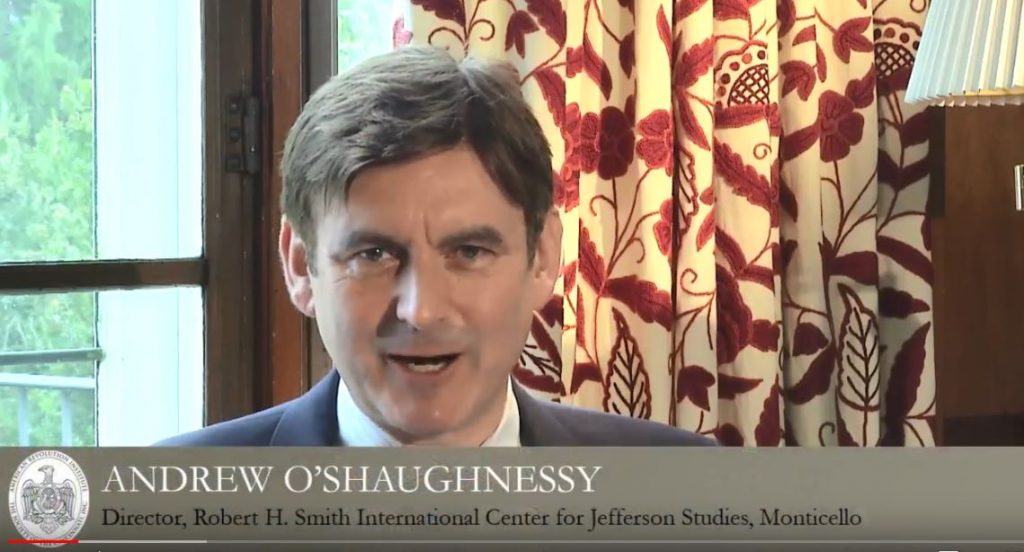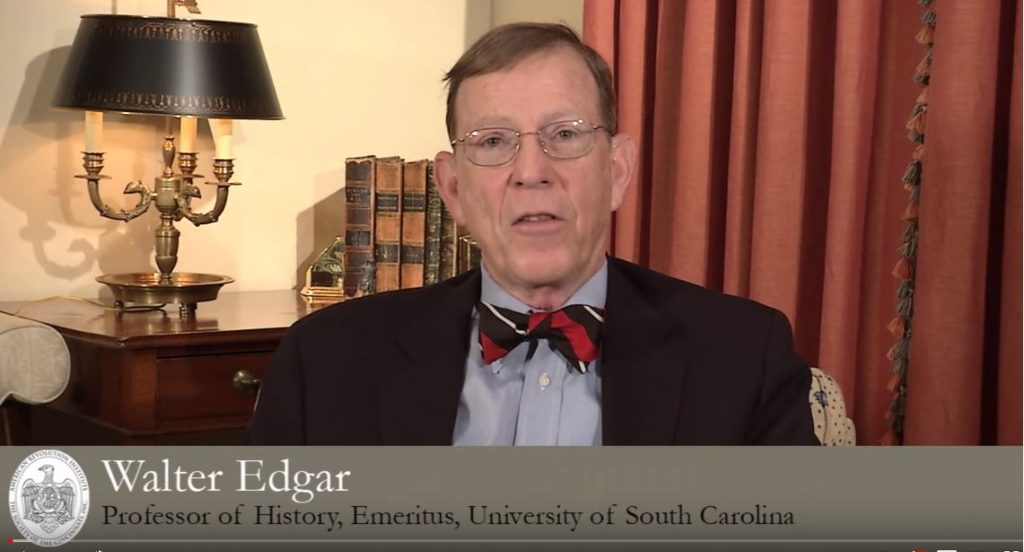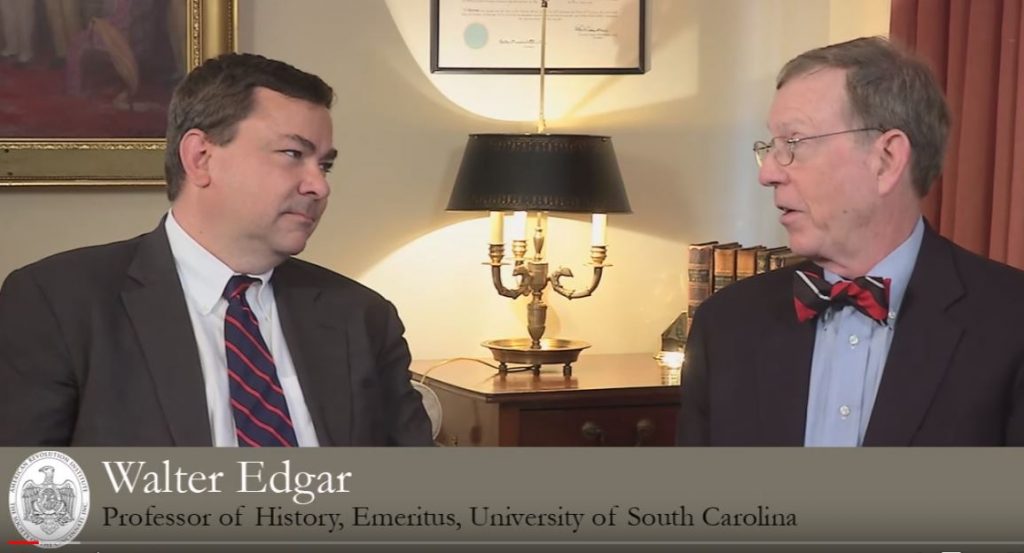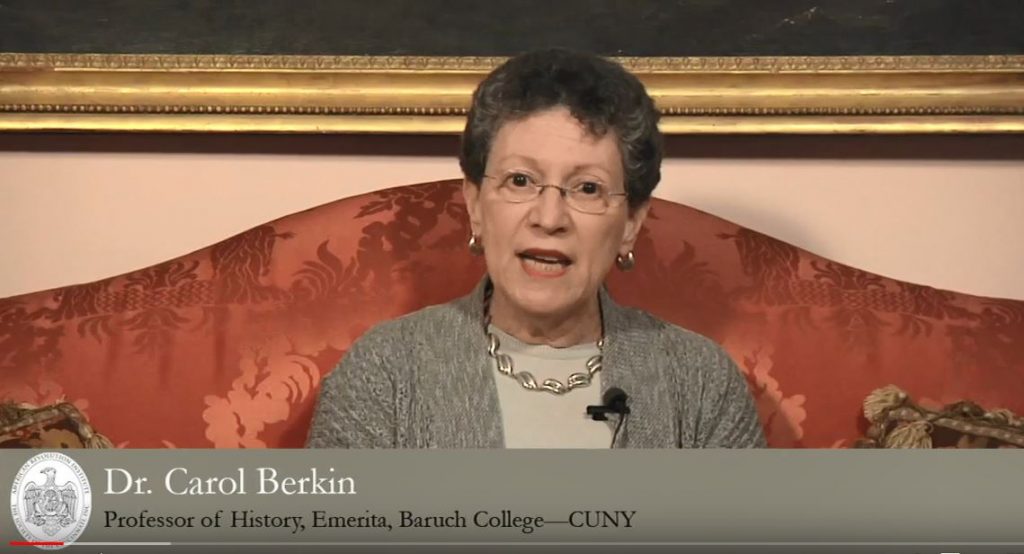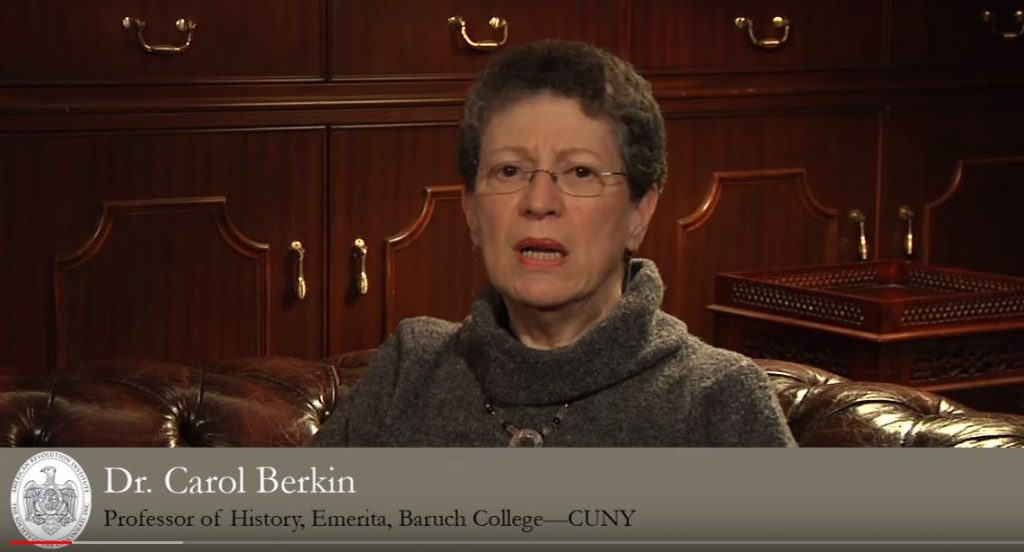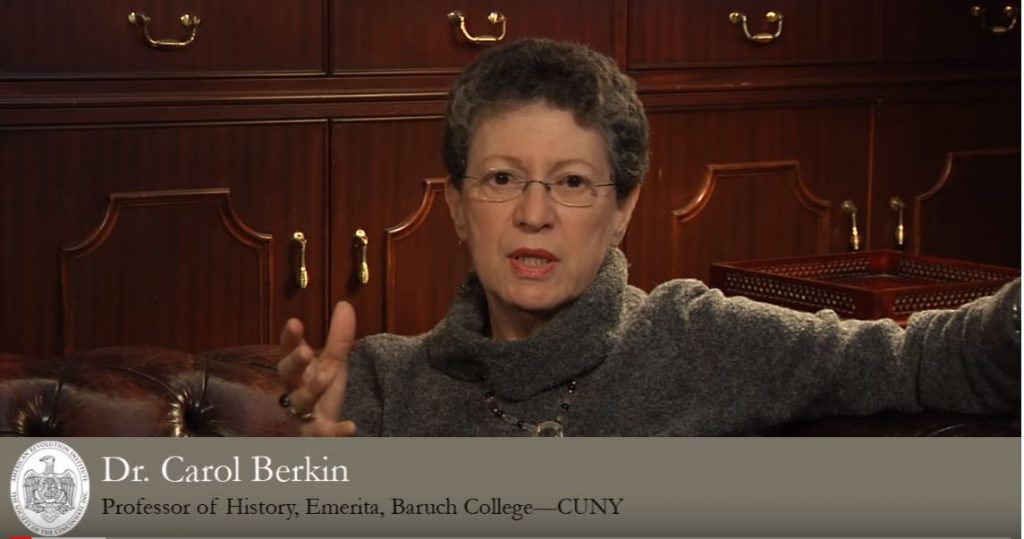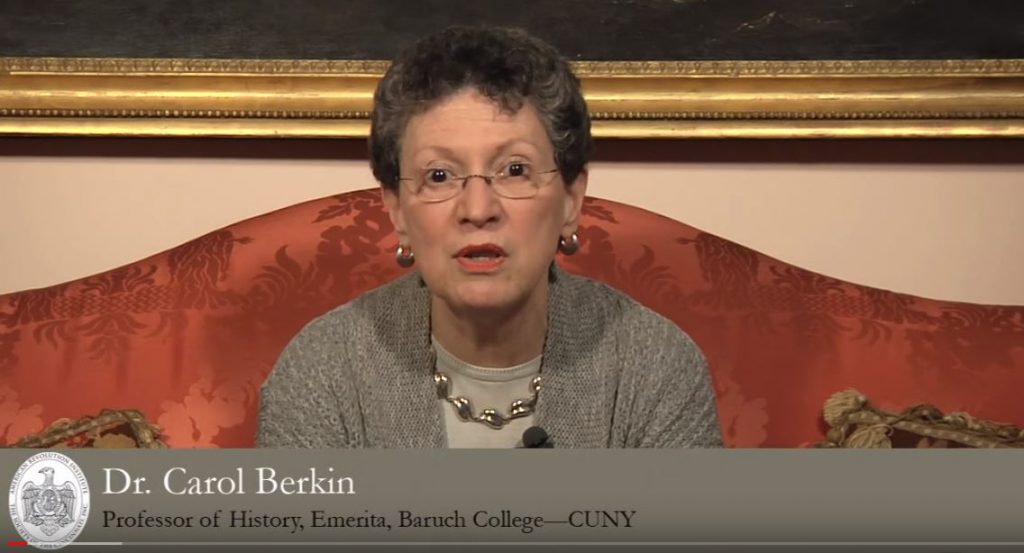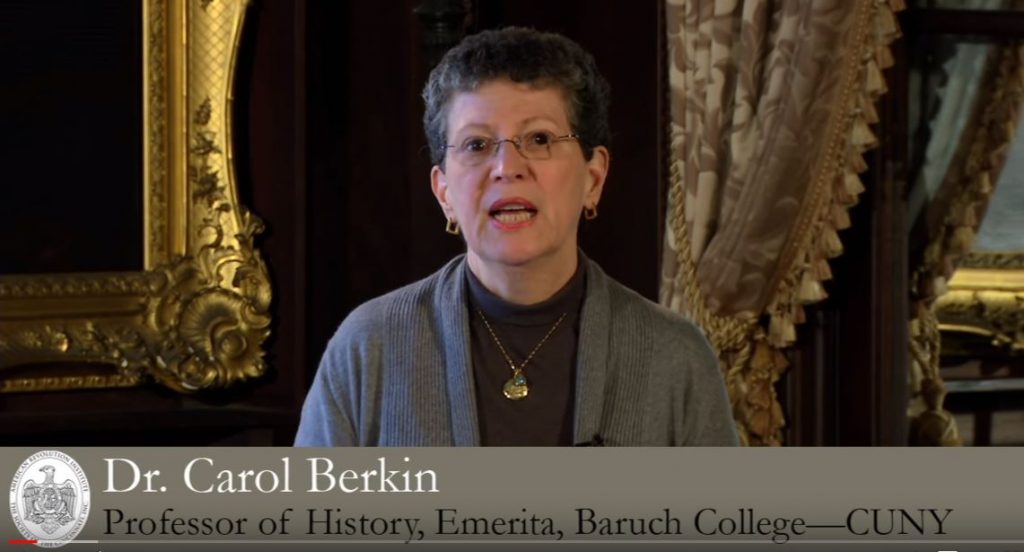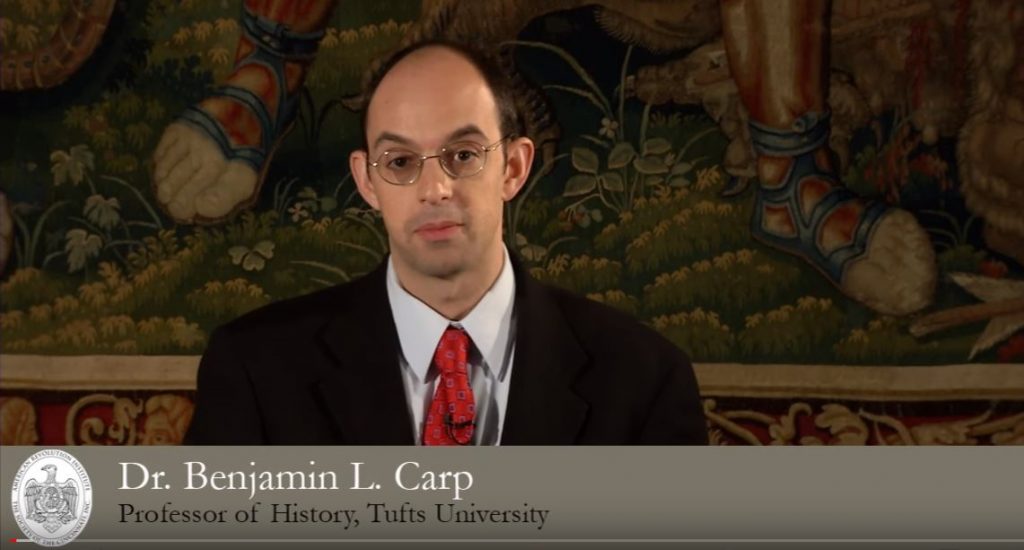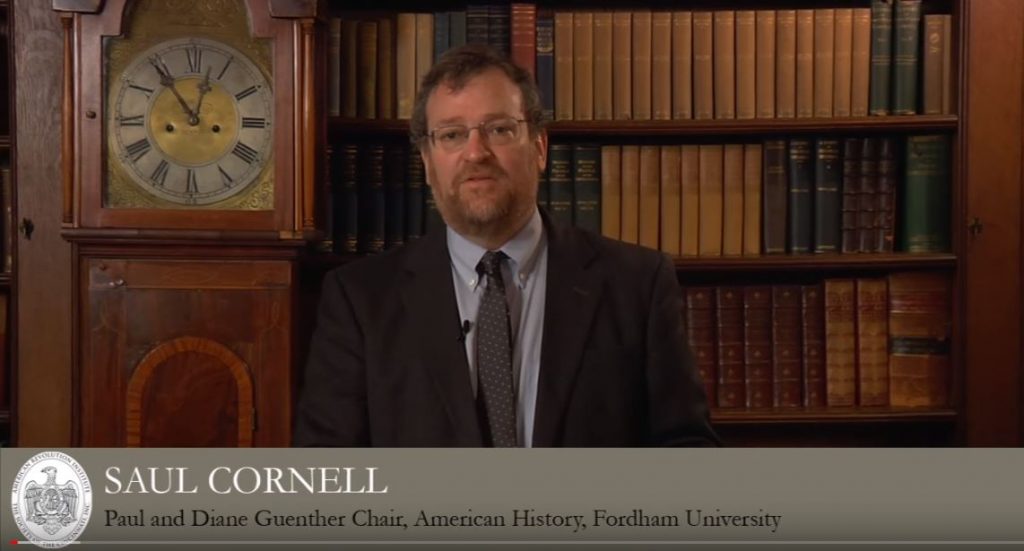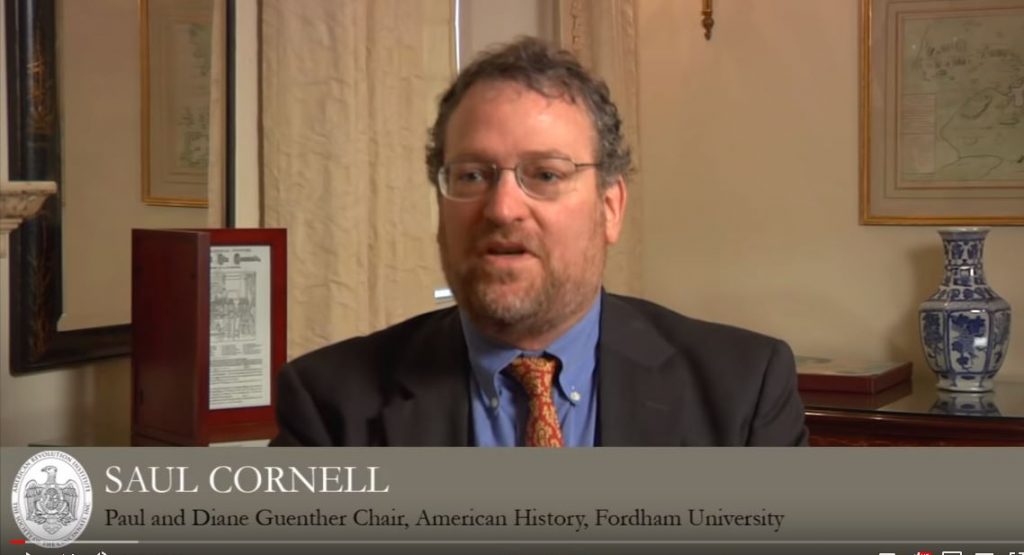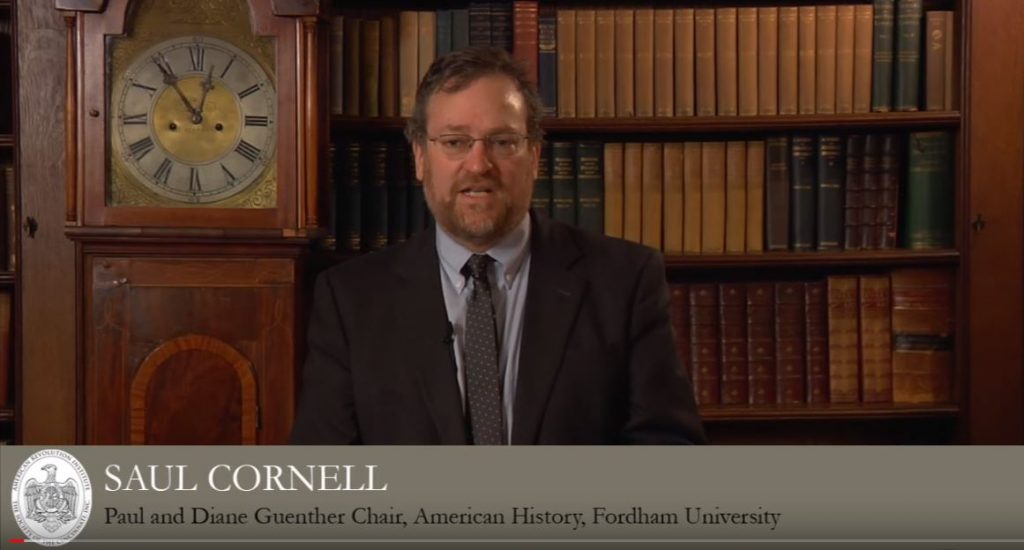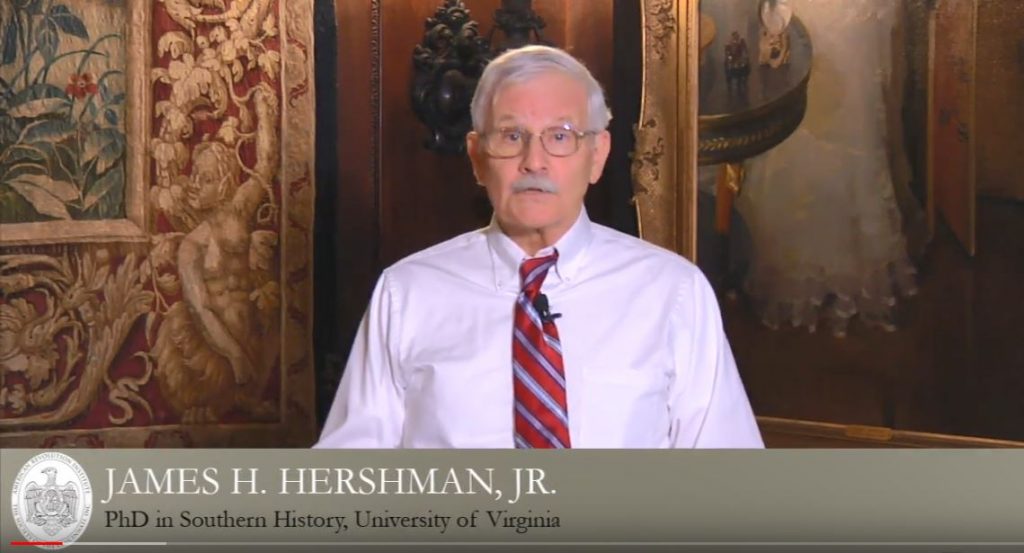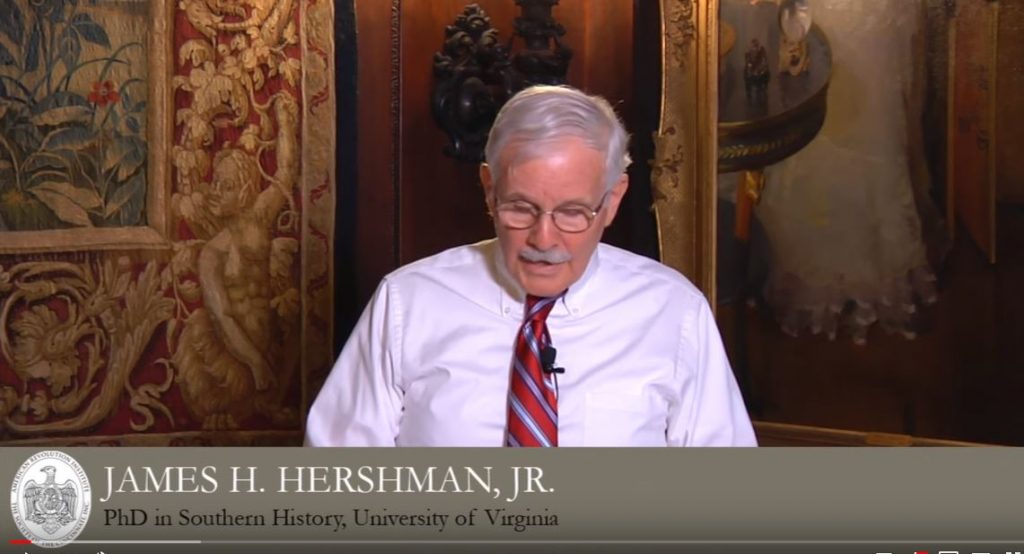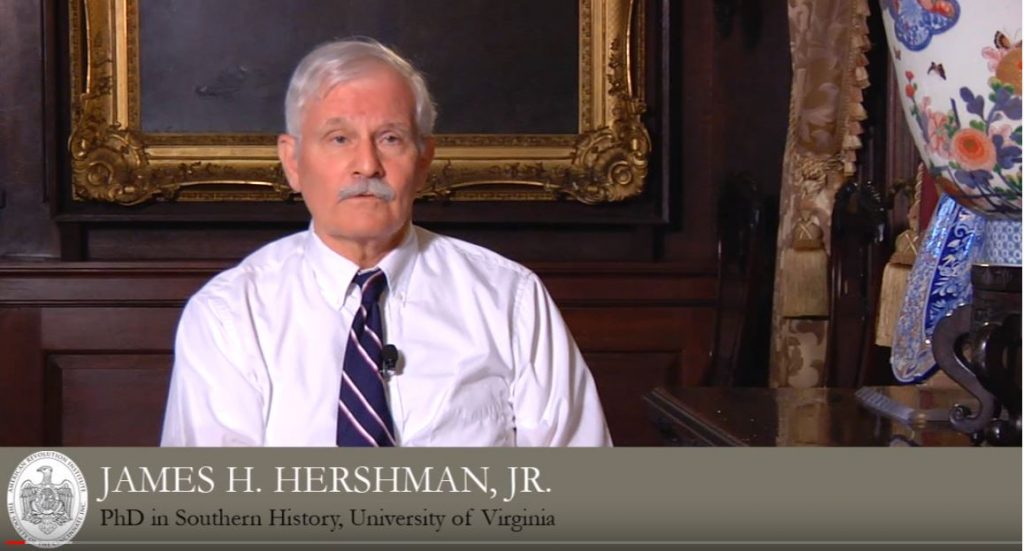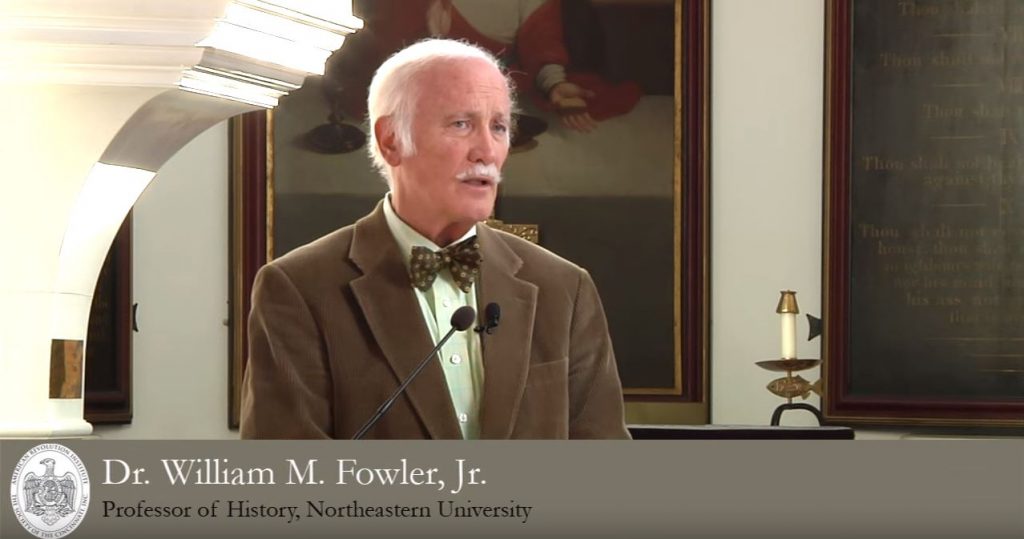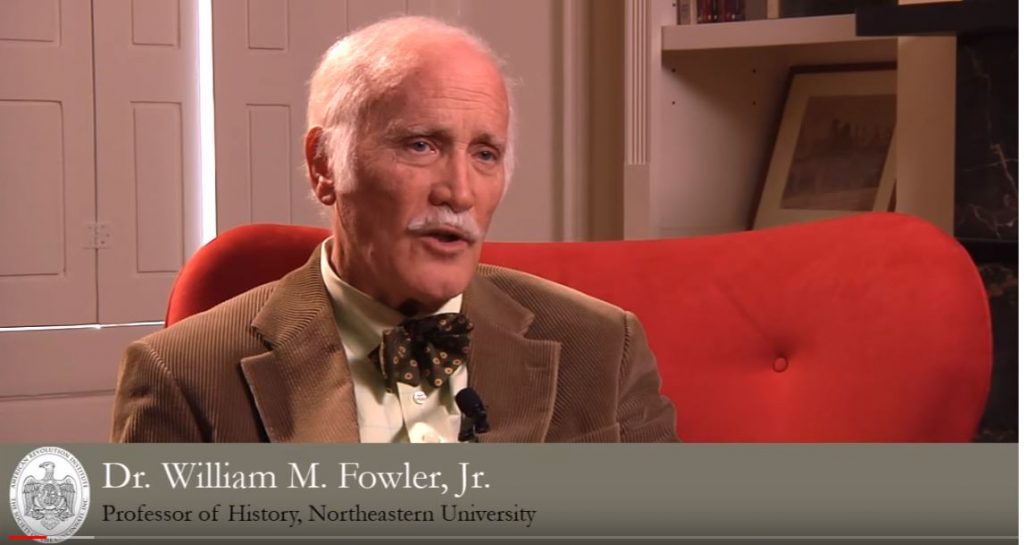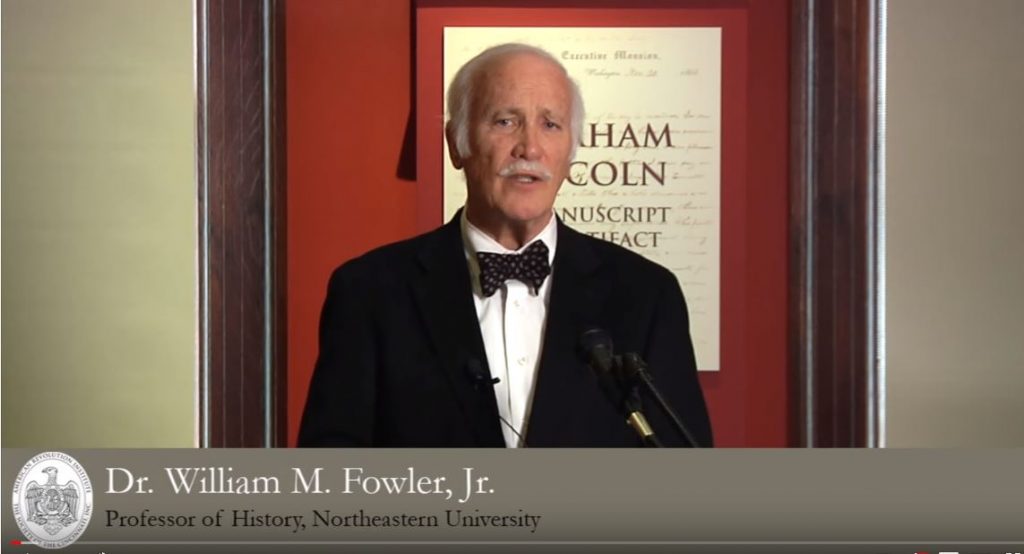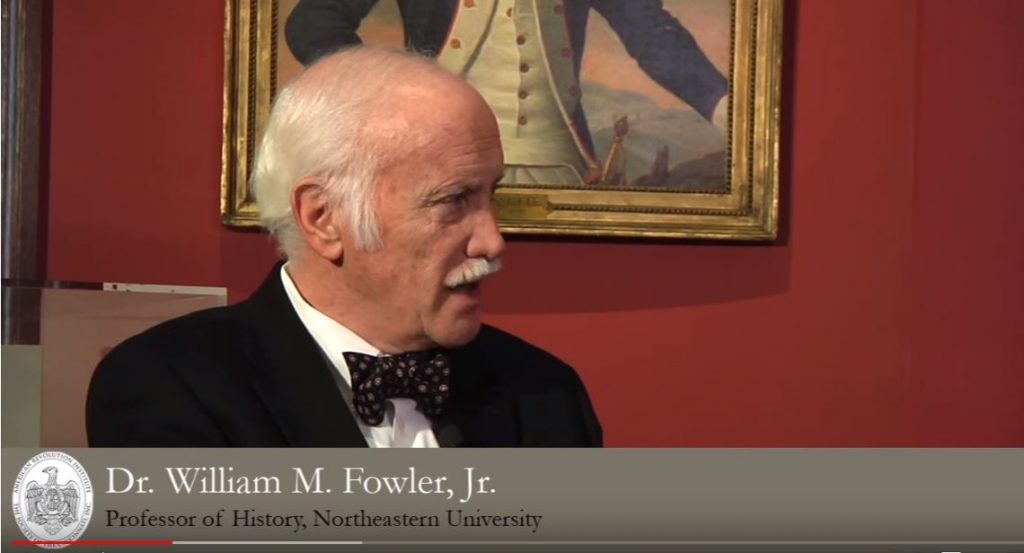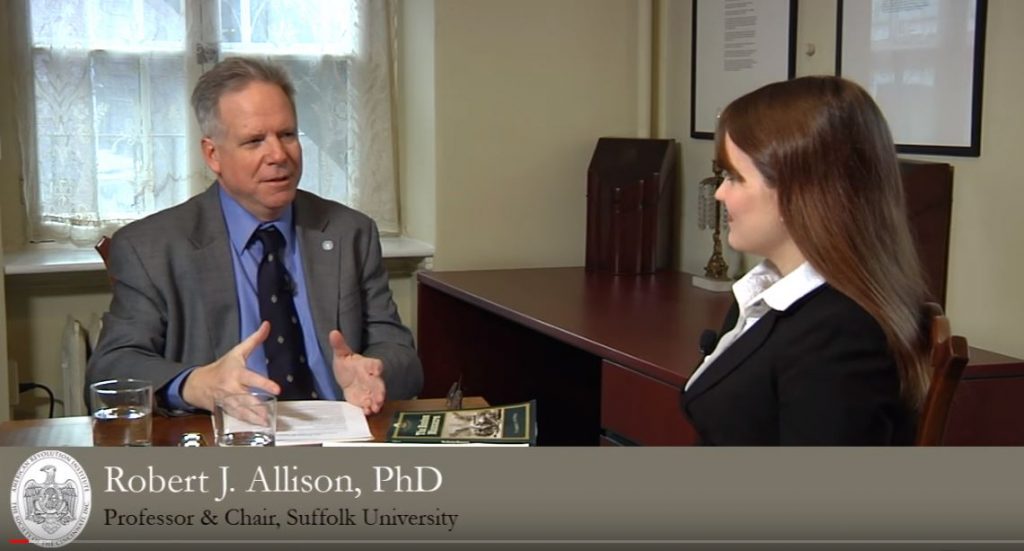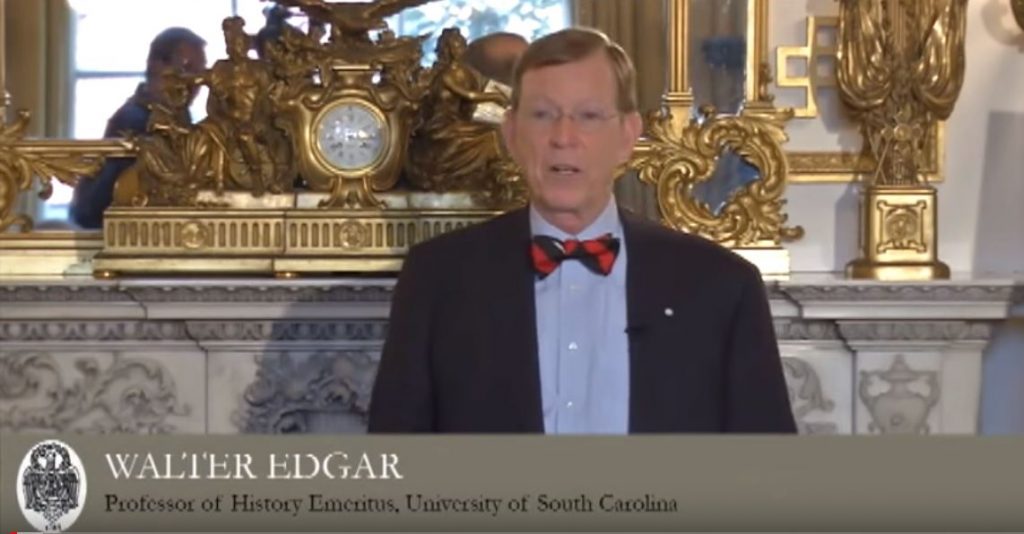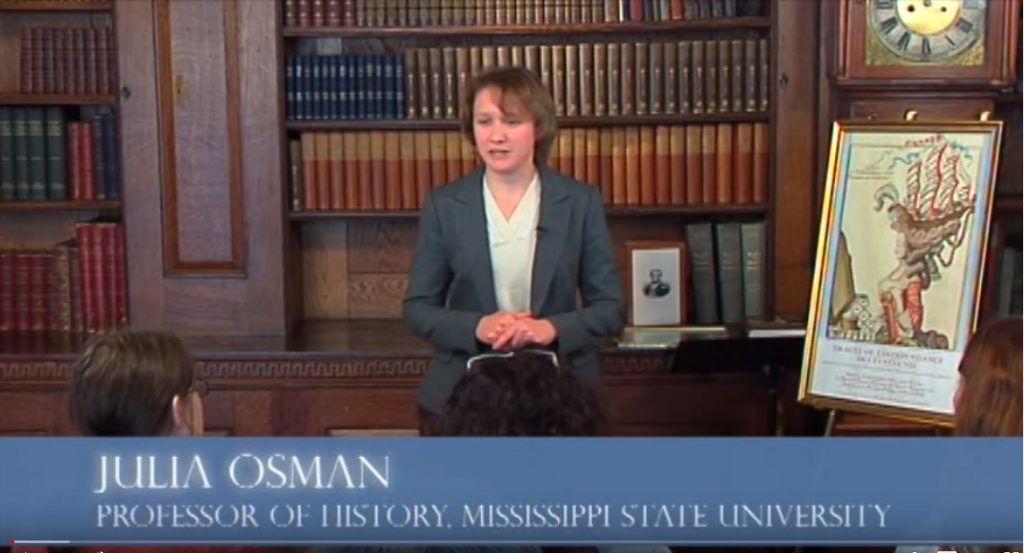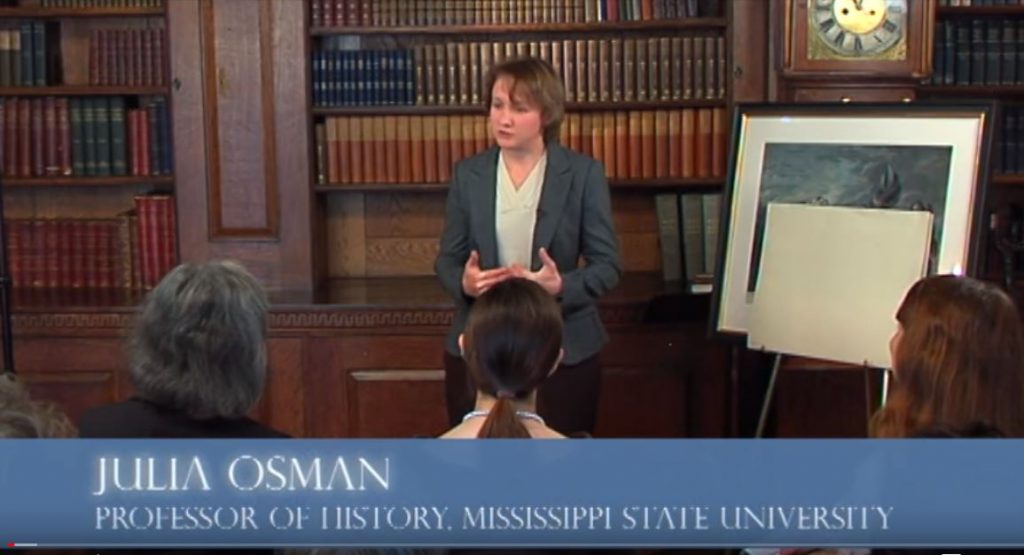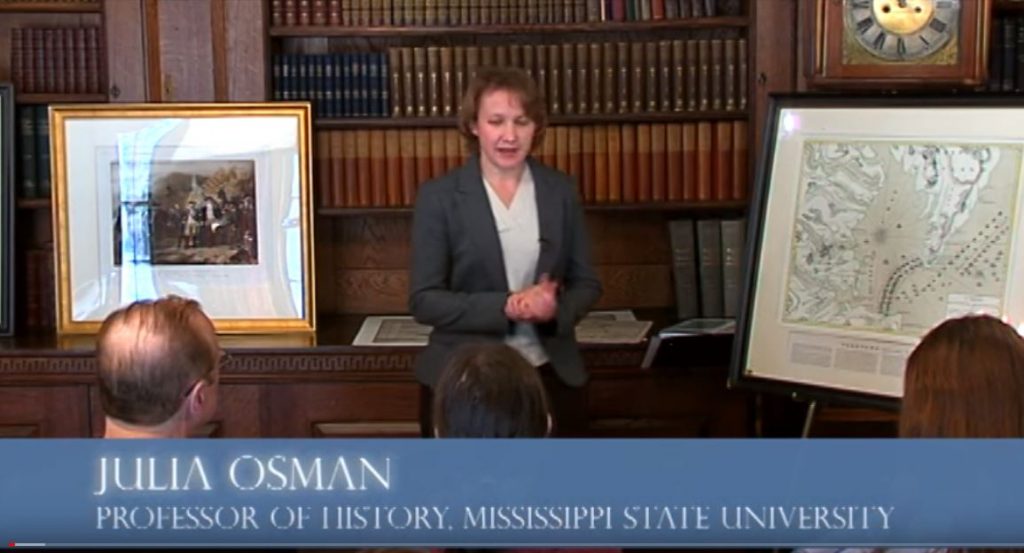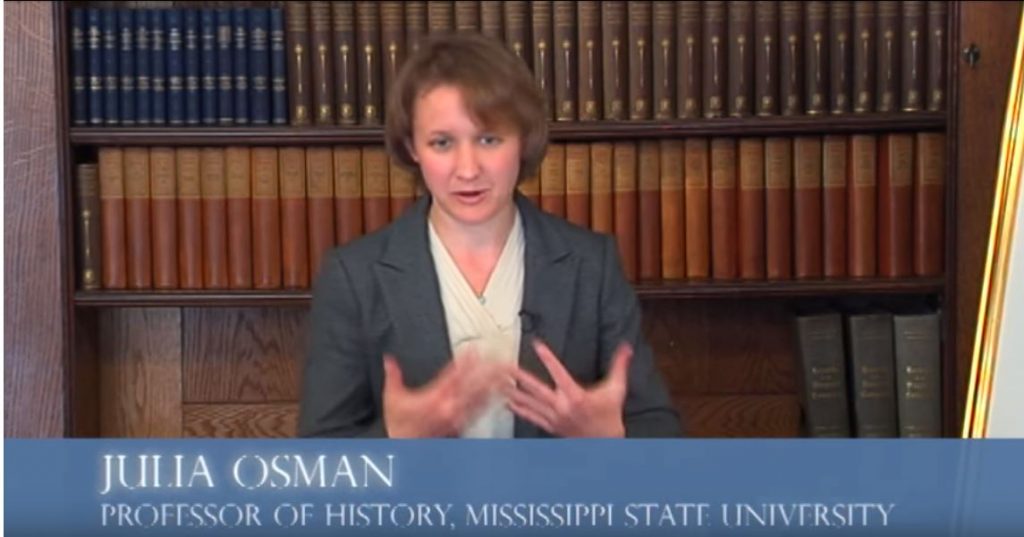The Institute’s classroom videos encompass two resource categories.
Some of today’s leading—and most engaging—historians and scholars on the period are featured in lectures and conversations on the fundamental themes of the American Revolution and its legacy, based in part on the Institute’s Revolutionary War Cultural Literacy standards. Each of these videos is available in full length as well as in shorter, chaptered segments ideal for use in the classroom or to assign to students to watch on their own.
For a focus on primary source objects, explore the treasures of our museum and library collections in our Collections Corner series. Each short video segment features a member of our staff discussing rare items in our collections, from prints and manuscripts to weapons and portraits.
The First French Map of the United States
In this segment of Collections Corner, the Institute’s research services librarian, Rachel Nellis, highlights a rare map from our Robert Charles Lawrence Fergusson Collection, Carte des Etats-Unis de l’Amerique suivant le Traité de Paix de 1783, engraved…
A Handkerchief Commemorating the Reign of King George III
Museum Collections and Operations Manager Paul Newman discusses a handkerchief commemorating the reign of British monarch King George III, made ca. 1812. The large printed handkerchief chronicles contemporary events in a lavishly decorated manner and includes several portraits of notable…
An Allegorical Portrait of a French Naval Officer
Deputy Director and Curator Emily Parsons discusses an allegorical portrait from our museum collections. Completed in 1783 by Parisian artist Nicolas René Jollain, the painting depicts Thomas François Lenormand de Victot, a fallen French naval officer from the Revolutionary…
Statues of Nathan Hale
“I only regret that I have but one life to lose for my country.” The words Nathan Hale is said to have uttered just before being hanged as a spy by the British are among the best remembered of the…
The Patriot’s Monitor
It’s back to school season! To celebrate, this month’s Collections Corner features the Institute’s director of education, Stacia Smith, discussing The Patriot’s Monitor, an 1810 American primer written by Rev. Ignatius Thomson of Pomfret, Vermont. As…
French Military Treatises of the Eighteenth Century
Coping with the sunset that followed Louis XIV’s death, battered by a string of costly military defeats, and influenced by the intellectual currents of the Enlightenment, the French army was primed for reform in the mid-eighteenth century. Scholar…
Early French Eagle Insignias of the Society of the Cincinnati
The Society of the Cincinnati’s Eagle insignia has been the most recognizable symbol of the organization and its members for more than two hundred years. Designed in 1783 by Pierre-Charles L’Enfant, the double-sided gold insignia bears…
The New Game of the American Revolution
This segment of Collections Corner features the Institute’s director of education, Stacia Smith, discussing The New Game of the American Revolution, a 2022 acquisition from our library’s Robert Charles Lawrence Fergusson Collection. Created in 1844 by the author…
A Handkerchief Commemorating the Reign of King George III
Museum Collections and Operations Manager Paul Newman discusses a commemorative handkerchief charting the reign of King George III, ca. 1812, through various political appointments, government ministries, and events of national and global interests. This handkercheif is a valuable artifact in…
Friedrich Wilhelm Steuben’s Regulations for the Order and Discipline of the Troops of the United States
On February 23, 1778, Gen. George Washington welcomed Gen. Friedrich Wilhelm Steuben of Prussia at Valley Forge. Throughout the Revolutionary War, Steuben was instrumental in transforming the Continental Army into a professional fighting force. This month’s edition of Collections…
Six Letters Written by Capt. Jonathan Birge
This segment of Collections Corner features the Institute’s research services librarian, Rachel Nellis, sharing a remarkable series of six surviving letters written from New York in the summer and fall of 1776 by Capt. Jonathan Birge of Bolton, Connecticut…
Anthony Walton White’s Silver Camp Cups
This pair of silver camp cups was owned by Anthony Walton White, an officer in the New Jersey Line and the Continental Light Dragoons during the Revolutionary War. The cups were made in Philadelphia about 1776 by silversmith Richard Humphreys…
Two Congressional Presentation Swords
This segment of Collections Corner features the Institute’s Museum Collections and Operations Manager Paul Newman discussing two Congressional presentation swords from our museum collections. Resolved by Congress on November 4, 1777, one sword was awarded to Marylander Samuel Smith…
A 1770 Edition of John Milton’s Paradise Lost
On October 17, 1777, British general John Burgoyne surrendered his army to American forces under Gen. Horatio Gates. To mark the 245th anniversary of this pivotal milestone in the Revolutionary War, this edition of Collections Corner features Library Director Ellen…
Lt. William Popham’s Orderly Book
On September 25, 1780, Benedict Arnold fled West Point and defected to the British as news of his betrayal spread. Our newest Collections Corner video features Research Services Librarian Rachel Nellis sharing an orderly book kept by Lt. William Popham…
The Historiscope: A Complete Panorama of America
The historiscope is an educational toy manufactured by Milton Bradley & Company of Springfield, Massachusetts, ca. 1868-1890. It features a scrolling set of hand-colored lithographs wound around two vertical wooden dowels with metal handles set into a cardboard…
William Truman Stoddert Portrait Miniature
This watercolor portrait miniature pictures First Lieutenant William Truman Stoddert of the Maryland Continental Line, who served in the Revolutionary War for six years. The portrait was painted about 1778 by Charles Willson Peale, the most important American artist during…
Spanish Model 1757 Flintlock Musket
The Spanish Model 1757 musket was the standard Spanish infantry firearm during the Seven Years’ War and the American Revolution. In June 1779, Spain formally declared war on Great Britain, creating a de facto alliance with the Americans and expanding…
The Institution of the Society of the Cincinnati
The most important and iconic treasure of the Society of the Cincinnati’s archives is the Institution, the document that formally established the organization of Revolutionary War veterans. On May 13, 1783, a group of Continental Army officers gathered at…
French Naval Engraving
This recently acquired 1790 engraving depicts two French frigates, the Astrée and the Hermione, engaged in battle against a convoy of six British warships off Cape Breton Island on July 21, 1781. Engraved by François Dequevauviller, after the…
Thomas Kempton Powder Horn
This engraved powder horn was made by an unidentified professional carver for Capt. Thomas Kempton of Massachusetts during the Siege of Boston in 1775. The powder horn depicts scenes of Roxbury and Boston, including the Boston lighthouse, a fort flying…
Revolutionary Choices Trailer
The men and women of the revolutionary generation won our independence and created a free and united republic. Can you do as well? You will face the dilemmas confronted by American revolutionaries as they struggle to recruit and supply troops…
Global Migration of American Loyalists
At the end of the American Revolution, sixty thousand Americans loyal to the British cause fled the United States and became refugees throughout the British Empire. Loyalists traveled to Canada, sailed for Britain, and journeyed to the Bahamas and the…
Oneida and Six Nations
The Oneida nation was the only one of the Iroquois Confederacy to ally with the Americans during the Revolutionary War. Congress formally honored the Oneida in 1794 for their service to the American cause, yet over time the Oneida sacrifice…
Benedict Arnold
American general Benedict Arnold secretly conspired with the enemy to surrender West Point and George Washington. Disaster for the Americans was thwarted only when Arnold’s co-conspirator, John André, was captured with plans of the West Point fortifications in…
A Well-Regulated Militia: History of the Second Amendment
Professor Cornell delves into the complicated history and interpretation of the Second Amendment to the U.S. Constitution. He argues that the amendment neither guarantees the right to own guns nor simply protects the rights of states to maintain militias…
An Empire Divided: Revolution and the British Caribbean
There were twenty-six colonies, not thirteen, in British America in 1776, and the majority of the colonies outside the mainland were in the Caribbean. Even though they shared many important similarities and connections with the mainland colonies, they did…
Lord North
The policies of Lord North, the British prime minister during the American Revolution, united the American colonies in rebellion. The Tea Act and the Coercive Acts solidified many colonists’ objections to what they considered British oppression. Dr. O’Shaughnessy examines…
Mel Gibson’s The Patriot: An Historian’s View
Mel Gibson’s film The Patriot, released in 2000, is a valuable teaching tool, as Professor Edgar argues in this look at its themes and accuracy. The film illustrates two important themes very well: the vicious, partisan nature of the…
The Southern Frontier in the American Revolution
The American Revolution did not begin and end in Boston. The backcountry in the South was an especially important region in the struggle for American independence. Professor Edgar examines the complicated factors that influenced the conflict in this region, including…
Native American Women and the American Revolution
The American Revolution was many revolutions, argues Professor Berkin, transforming the lives of Native Americans while the colonists fought for independence. For many Native Americans, victory meant increased pressure from white settlers. Native American women shared their peoples’ struggles for…
Revolutionary Transformation of Women’s Role in Society
The Revolution transformed the role of women in American society. Law and custom in colonial America reflected the idea that women were morally inferior to men. Mothers bore and nursed their infants, but the task of teaching children right from…
Women Who Followed the Continental Army
In the popular imagination, men conducted the Revolutionary War and the Continental Army and its encampments were an all-male environment. Professor Berkin reveals that, in reality, women and children accompanied the army and provided important services to sustain it…
African American Women and the American Revolution
African American women longed for freedom as much as anyone in revolutionary America, but few enjoyed its blessings. Liberty proved elusive, whether offered by the British or articulated by American revolutionaries. Some African American women in Virginia liberated themselves in…
Daughters of Liberty and Loyalist Women
Professor Berkin illuminates how women—both supporters of American liberty and loyalists to the Crown—participated in the Revolutionary War and the challenges they faced during the period. Patriot women maintained boycotts of imported goods, joined the army disguised as…
The Global Tea Party
The Boston Tea Party was not just a local story, Professor Carp argues, it was also a global story. The East India Company was becoming a territorial power in South Asia. Its principal import, tea, came from China and was…
Civic Virtue in Early America
Revolutionary Americans regarded civic virtue—a willingness to sacrifice personal interests for the good of the community—as vital to the preservation of republican institutions. The ideal of virtuous citizenship was rooted in classical antiquity and influenced American political thought…
From Articles of Confederation to US Constitution
After winning its independence, the new American republic faced internal threats to its survival political, economic and cultural differences resurfaced during the return to peacetime. These pressures prompted the nation’s leaders to abandon the loose confederacy formed during the…
U.S. Constitution as the Fulfillment of the Revolution
The creation and adoption of the U.S. Constitution was a fulfillment of the American Revolution, not a conservative counterrevolution. Professor Cornell details how James Madison, known as the architect of the Constitution, arrived at his proposal for the delegates…
The Revolutionary Challenge to Slavery
The Revolutionary War disrupted the institution of slavery in the United States. Lord Dunmore’s 1775 proclamation in Virginia promised freedom to men enslaved by rebel masters if they would fight in the royal army. The additional social unrest provided…
From the Revolution to the Civil Rights Movement
A powerful thread connects the American Revolution and the civil rights movement of the 1960s: the world-shaking proclamation of the Declaration of Independence “that all men are created equal” and have an undeniable right to “life, liberty and the…
Slavery and America’s Revolutionary Leaders
Slavery is the great American contradiction. The independence of the United States held the promise of liberty and equal rights for all, yet the country’s founding documents permitted slavery to endure. Indeed, many of the men who wrote and…
Revere and Longfellow
“Listen my children and you shall hear.” With those lines, Henry Wadsworth Longfellow began his epic poem about Paul Revere’s ride on the night of April 18, 1775. When it was first published in 1861, the poem was an…
The Revolutionary War at Sea
Battles at sea played a key role in securing American independence, even though the size and prowess of the Royal Navy dwarfed that of the nascent Continental Navy. John Paul Jones, who defeated the HMS Serapis, became the great hero…
The Critical Time After Yorktown
Many people assume that the Revolutionary War ended with the surrender of the British army at Yorktown in October 1781. In fact, the war continued for two more traumatic years. During that time, the Revolution came as close to being…
Hardships of the Continental Army
The soldiers of the Continental Army suffered extreme hardships during the Revolutionary War. Beyond experiencing the terror of combat, the troops were chronically undersupplied. The close of the war brought further anxiety as many of the soldiers had not been…
The Boston Massacre and the Boston Tea Party
The people of Massachusetts had more power over their own government than anyone else in the British Empire. Bitterness and resentment festered among these independent-minded colonists as the Crown raised taxes on American goods and sent soldiers to enforce…
The South in the American Revolution
For the latter part of the American War of Independence, the British focused on taking control of the South. They captured Savannah and Charleston and launched a campaign to crush rebels in the Carolinas and Virginia. George Washington responded to…
Rochambeau and Lafayette
The marquis de Lafayette and the comte de Rochambeau were each vital to the fight for American independence, but they took different paths to their service in the American war. Unlike most other French officers, Lafayette did not seek a…
The Seven Years’ War
Winston Churchill called the Seven Years’ War the first world war. Yet, Americans typically think of this conflict only in terms of its North American theater, where it is most often referred to as the French and Indian War. The…
Victory at Yorktown
In August 1781, British commander Lord Cornwallis moved his troops to Yorktown, Virginia, hoping he could more easily receive supplies and reinforcements via the York River, near the Chesapeake Bay. Professor Osman details the events that followed, leading to the…
King Louis XVI
King Louis XVI’s people called him the “Liberating King” for his support of the American Revolution, so how did he end up beheaded at the guillotine? Professor Osman assesses Louis XVI’s conduct during the American and French Revolutions…
